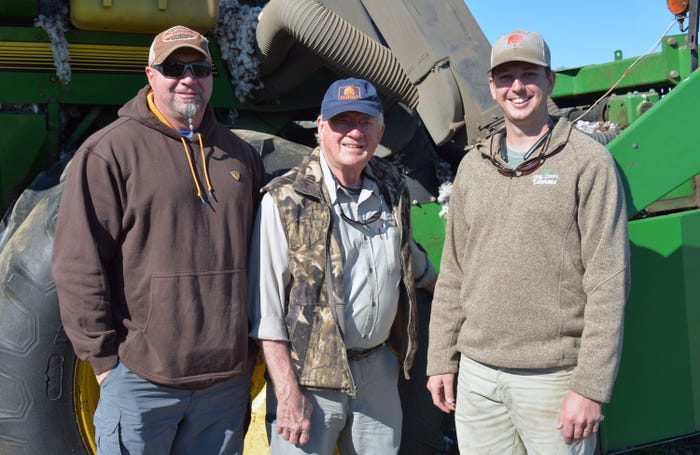
Early on, Garrett Dixon wasn't sure he'd become a full-time farmer. But he's been dialing in his operation over the years and is not taking anything for granted.
"When I was young, I wasn’t sure whether or not I'd have my own farm, but I wanted to be in production ag in some shape or form," said Dixon, 29, who farms in Lee County, Ala.
Spending time with Dixon, you pick up quickly his natural optimistic manner and practical style, both handy tools for farming. But he started his farming venture during un-optimistic times.
"The market timing when I started with row crops probably wasn't that great, but I felt as long as we could keep scratching along until we got in a better pricing cycle, we could make it," Dixon said.
Having access to family land helped his plans. Dixon's mother, Ann, is from Lee County, where her family has farmed since the mid-1800s. His father, Ken, farmed with his family down in the Florida Panhandle. But the 1980s, as many know, was a tough time to make it in farming.
Dixon rents the family land from his uncle Ed Gullatte and from his grandmother Sarah Gullatte. The land was in pasture or hay at the time Dixon started farming, but over time he's worked it back into agronomic shape for peanuts and cotton, but it's been a stepped process.
Tried cotton
After graduating Auburn University in 2014 with an animal science degree, Dixon's first crop attempt was 120 acres of soybeans, which didn't turn out well due to tough weather and tougher prices. In 2015, he planted sesame, which, though interesting to grow, wasn't going to keep him a full-time farmer.
In 2016, he decided to have a go with cotton. Not knowing what he didn’t know yet about cotton and more, he went looking for people who did. His uncle was a valuable starting place, but Gullatte hadn't grown cotton in more than 15 years, and the technologies and systems had changed a lot over that time. It's good to remember that in 2016 cotton prices were staggering at mid-60-cents per pound and cotton was not a covered commodity in the farm bill.
Dixon searched out and found farmer mentors who knew how to grow cotton, and he turned to the Alabama Cooperative Extension Service, particularly his local agent, and that set him on the right path.
"I feel fortunate every year we've been able to refine the process, and as I began to grow cotton the yields began to improve, and my agronomics and management of the crop has gotten better," he said.

Garret Dixon, far right, looked for people to help him get started with cotton, including farm mentors and Extension specialists. He is pictured in his 2020 cotton field with Ron Smith, longtime Extension entomologist at Auburn University, and Shane Smith, Garrett's crop consultant.
He added peanuts for a rotation in 2019.
This year, he will grow 600 acres, which will include Deltapine 1646 and a bit of DPL 2038 for the cotton and FloRun331 and AU-NPL 17 for peanuts. He's on to a system now, "but it's still a moving target and it can always get better," he said. "For example, I don't think my soil fertility will ever be like the Midwest with our sandy soil type, but I've watched the CEC (Cation exchange capacity) values increase and that's encouraging."
The rotation
He's looking at three-year cotton to one-year peanut rotation, soil sampling a 2.5 acre grid every three years. Each year before every acre of cotton, he applies chicken littler, which goes out with his variable-rate spreader. He also variable rates his lime and gympsum. He used wheat cover when he first started because it was the cheapest, but on the guidance of a mentor farmer switched to rye, which provides more biomass for him.
He strip-tills into the cover. The land will only be broken every three years from peanut digging.
He is mostly non-irrigated, but this year, he is installing his first pivot, which will cover about 75 acres. He irrigates some fields with a travelling gun.
Even with freak hail damage and near-record rainfall in 2020 for his region, he averaged 900 pounds per acre on his cotton, which he thinks he's getting closer to dialing in. His peanuts still need some work, he said.
His peanuts averaged around 3,000 pounds per acre. He is still dialing in the peanuts. In 2019, he had some quality issues, hitting more Seg 3s then he'd like. In 2020, his quality was much better, but with a wet harvest he felt he had too many falling off the vine. He also believes he was spreading his lime too late before planting and not giving the soil Ph enough time to move. He used dry inoculant the last two years, but will switch to a liquid product for this year's peanut planting.
He said 2021 does look better for pricing and he has contracted his peanuts at a better price than last year. He markets his cotton through Staplcoton.

Dixon appreciates good networking and connections. For him, that's part of farming. He met Robin while attending Auburn University. They married in 2017. She is an agriscience teacher and FFA advisor.
In college, Dixon was Auburn University Young Farmers chairman and in 2019 the Alabama Farmers Federation’s State Young Farmers Committee chair. He served on the federation's state board of directors as an ex-officio member. He's a champion for organization and for getting young farmers involved.
"The federation and Extension Service along with FFA are all good organizations. And for us being involved, getting to know other farmers and young farmers who want to get started, too, has been very beneficial and rewarding," he said.
About the Author(s)
You May Also Like






